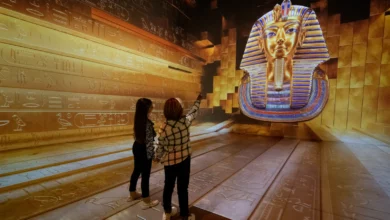Coincidentally, as Tora prison marks its 83rd anniversary in May, toppled President Hosni Mubarak will celebrate his 83rd birthday.
Not only that, but Mubarak may have to celebrate in the prison. A considerable number of political activists — and more recently corrupt officials from Mubarak's former regime — know the place quite well.
Tora prison has gone through several stages in the last eight decades. It has close connections with the opposition and with key events in Egyptian history.
Mostafa al-Nahhas Pasha, who served in government during the second quarter of the twentieth century, ordered its establishment to reduce overcrowding at Abu Zabal prison. As time passed, it expanded to include another seven prisons: Mazraa, Liman Tora, Istiqbal Tora, Mahkoumi Tora, and Aqrab.
The prison has a small hospital and a ward for businessmen and former ministers indicted in corruption cases. It also has a football pitch and court for playing volleyball and tennis.
In 1977, after the Bread Riots, the prison was developed properly from the decrepit condition it had been in since its establishment in the monarchical era. Increasing public pressure on Sadat meant he expanded the prison and established Istiqbal Tora to accommodate a rising number of opponents.
As popular protests peaked in 1979 after the signing of the Camp David Accords with Israel, the prison was expanded yet again. Annexes were built and the prison was extended vertically. Former Interior Minister al-Nabawi Ismail oversaw the renovations. Simultaneously, the number of security guards and patrols was increased.
Even though Sadat claimed parts of the prison were demolished, accounts from contemporary eyewitnesses indicate that the prison remained intact.
In 1981, the number of detainees rose again as Sadat ordered the arrest of professors, journalists and politicians opposed to peace with Israel. The prison for political extremists and regime opponents now housed members of the Egyptian elite. Security was beefed up with additional forces from Central Security and the special forces.
With the assassination of Sadat in 1981 a new phase for the prison began. Mubarak took power and at the beginning of his reign many members of extremist groups were sent to Tora, along with members of other political movements.
In 1985, Mubarak’s struggle with Islamic groups intensified, and increasing detainee numbers again required a larger number of cells. Istiqbal Tora was expanded.
In 1986, Zaki Badr was appointed minister of interior. Detentions and persecution were key parts of Badr’s mandate.
Badr’s approach was reportedly violent. He oversaw arbitrary detentions, and the prison’s management was described as brutal for using various methods of torture, including electric shocks, according to eyewitnesses.
Meanwhile, new interrogation teams were formed to handle the activities of radical Islamic groups.
When Hassan al-Alfi became interior minister at the beginning of the 1990s, he redesigned the prison to make it better protected and secured, in a fashion similar to US prisons. It is believed their renovation was the idea of a number of police officers who were trained in the US.
Habib al-Adly, the head of the State Security apparatus at the time, contributed to the quick implementation of these ideas.
After Al-Adly became interior minister following the terrorist attacks in Luxor in 1997, he worked on completing the implementation of the new system of prison security. In the meantime, he launched several arrest campaigns under the pretext of defending Egypt from terrorism.
In 2004, the Dahab and Sharm el-Sheikh bombings sparked yet another series of arrests, in which thousands of people were taken to Tora prison. Most of the detainees, according to an NGO report, were not linked to the attacks.
There, they were tortured in several ways, which led them to go on strike in 2006. Several rights organizations revealed violations committed at the prison. The stink of torture and criticism by several foreign human rights organizations proved embarrassing to al-Adly, who led an undeclared campaign to improve the image of Egyptian prisons, emphasizing that the new philosophy of prison management was based on the good treatment of prisoners.
Still, Amnesty International received information stating that several prisoners were subjected to electric shocks and other forms of mistreatment, besides being kept in solitary confinement for years.
The organization sent a message to the attorney general calling for a transparent investigation into the alleged incidents of torture, but it never received an response.
Human rights violations at Egyptian prisons received the attention of Egyptian rights organizations, which, in their reports, cited the confessions and accounts of detainees and eyewitnesses from inside Tora.




